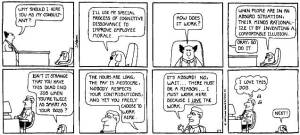(This is part two in a two-part post on the psychopathic brain. You can find part one here.)
3.
Testing someone for psychopathy is a time-consuming process. “You have to do a very thorough study. It takes me three to four hours with somebody,” says Jonathan Pincus. “That’s the time I spend with the individual, examining him, questioning him and talking to him — and it takes a psychiatrist at least double that time.” That all comes before conducting a PET scan, and that time doesn’t include the background information one gleans from examining the medical, police, and school records a modern neurologist would have at his disposal. This begs a question: if it takes the foremost experts on psychopathy at least three hours to determine someone is psychopathic, how can we trust the gut reaction of a 19th century policeman? How seriously should we take the claim that Lizzie Borden was psychopathic?
In the 1890s, one could hardly say that the field of psychology was even in its infancy. Hysteria was treated with vibrators. Lunatic asylums were very much in vogue. This was an era before malaria was used to treat insanity, and likewise before lobotomies had even been invented. The ideas of Jung and Freud were fifteen years from gaining traction in the scientific community, and forty years from receiving any sort of mainstream acceptance. All that to say, even among medical professionals there was no actual understanding of what a psychopath looked like, and the perception among the general population was even more naïve.
So what does it mean that Lizzie Borden seemed too calm and collected? Ultimately, it means nothing at all. One would expect that a child who finds the murdered remains of her father to be in hysterics. But how we would expect people to react often bears little similarity to how they actually react. People in the aftermath of trauma have been noted to act in a variety of ways. Some get manic. Some go into shock and become catatonic. Lizzie’s behavior in the hours after her father’s death are meaningless in determining her guilt.
Crime historian Bill James offers a simple paradigm for how to think about criminal evidence. “Real evidence bears not the slightest resemblance to the so-often-cited structure of motive, means, and opportunity.” James points out that thousands of people have the motive, means, and opportunity to commit crimes every day and do not. “Suppose that you try to apply this concept of ‘proof’ to some ordinary event. Let us suppose that the prosecution is trying to prove that you purchased a melon last Saturday.” Virtually everyone you’ll come into contact with could be said to have the motive, means, and opportunity to purchase a melon. You get hungry, and melons are delicious. Melons are extremely cheap. Almost everyone lives in close enough proximity to a grocer that they could purchase one. None of this constitutes proof that you purchased a watermelon.
Too often, people are accused and convicted of crimes due to the inappropriate amount of weight placed on circumstantial evidence. “Real evidence that I purchased a watermelon,” says James, “is like a sales receipt for a watermelon with my fingerprints on it, a check that I wrote to the grocery store for that amount on that date, and a videotape of me carrying a watermelon out of the store. There’s a half-eaten watermelon in the refrigerator and watermelon rinds in the garbage; you got me.” What matters most, then, is physical evidence, not the directional arrow that gives you a place to start the search for suspects. “Motive, means and opportunity, you’ve got squat.”
What, then, is the physical evidence against Lizzie Borden? In short, there is none. No murder weapon was ever found. There were no witnesses that saw her commit the crime. Perhaps most significant of all, there was no blood on her. Not on her hands; not on her clothes; not in her hair; not on her shoes. No clothes in the home were found to have blood on them. Even the police officers who raised eyebrows at Lizzie’s alleged coldness at the crime scene didn’t fail to notice that she didn’t have a drop of blood on her. If you can stomach it, go back to my description of Emma’s attack. Then try to imagine a scenario by which such an attacker could avoid getting blood on them.
4.
In 2012, a Swiss medical doctor named Franz Messerli found himself looking at how much chocolate is eaten in various countries. He noticed a strange pattern: the more chocolate the average person of a country ate, the more Nobel prizes were won by citizens of those countries. The Japanese, for example, eat a little more chocolate than the Chinese – about two kilograms per year, compared to less than half of that in China – and the Japanese have more Nobel laureates on average than the Chinese. In the Netherlands, they eat about about three times as much chocolate as the Japanese; the Netherlands earns Nobel prizes at ten times the rate of Japan. (Messerli also noticed – one imagines with a good deal of pride – that his native Switzerland leads the pack both in terms of chocolate consumption and Nobel prizes.) Says Messerili: “since chocolate consumption has been documented to improve cognitive function, it seems most likely that in a dose-dependent way, chocolate intake provides the abundant fertile ground needed for the sprouting of Nobel laureates.” It would seem that eating chocolate makes us smarter.
Not so fast. It would take a serious leap of faith to think that binging on Hershey bars will turn anyone into a world-class chemist or economist. Ashutosh Jogalekar, writer for Scientific American, says, “if only three rules of scientific deduction were inscribed on the doors of every university and research organization in the world, one of them should be that ‘correlation does not mean causation.’” Jogalekar is critical of Messerli’s argument. Messerli has roughly shown that chocolate consumption is strongly correlated to Nobel prizes. But is there any reason at all to think the two are more than loosely related? “What I find absolutely baffling,” Jogalekar says, “is that he makes no attempt to dissect other possible contributing factors. In fact at the end of the article he acknowledges the existence of such factors and then proceeds to dismiss them.” Chocolate consumption is correlated to affluence; affluence is correlated to more educational opportunities. Perhaps winning the Nobel prize is more a factor of education than it is of how much chocolate one eats.
The logic that underlies the claim, “chocolate eaters win more Nobel prizes” is the same logic that James Fallon employs when he says “decreased activity in the orbital cortex causes psycopathy.” Chris Chambers, senior research fellow in cognitive neuroscience at Cardiff University, asks, “Suppose we were to find that psychopaths, on average, show reduced activity in a particular brain region compared with a healthy control group. What would that mean, exactly?” Fallon is assuming that this reduced activity demonstrates psychopathy; Chambers isn’t so sure. “Maybe the reduced activity caused psychopathy. Or maybe it was the symptoms of psychopathy that caused changes in that part of the brain. Or maybe the brain activity is completely unrelated to psychopathy – a mere witness to the crime.” Knowing that psychopaths have a certain brain issue is one thing; understand the complex relationship between those two things is quite another.
But there’s more. Fallon has shown that, at least in terms of the set of psychopaths that made themselves available for PET scans, that those people have decreased function in their orbital cortex. Has he likewise shown that everyone with that brain artifact is a psychopath? This is called the “reverse inference fallacy.” If all cars have four wheels, is everything with four wheels a car? Of course not. Likewise, if James Fallon has physical characteristics correlated with psychopathy, is he the born killer, as he says “in one sense” that he is? Or does the fact that he’s a law-abiding citizen who has never raped or murdered anyone demonstrate that he is, in fact, not a psychopath after all? When all is said and done, is what qualifies such a definition is the expression of its behavior, or the potential for that behavior? A person with a charisma, a great singing voice, and a repertoire of songs is not a performing artist until she steps onto a stage and performs; can we call a person with the fire triangle of psychotic traits a psychopath before they behave psychotically?



